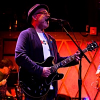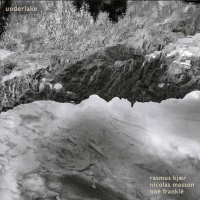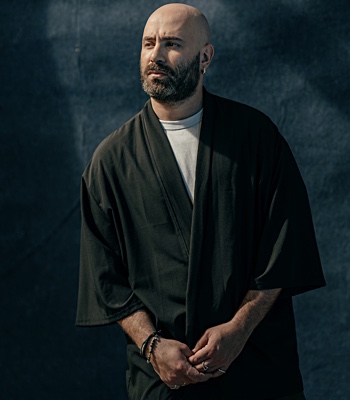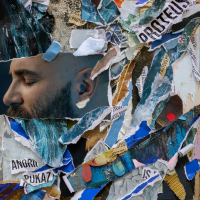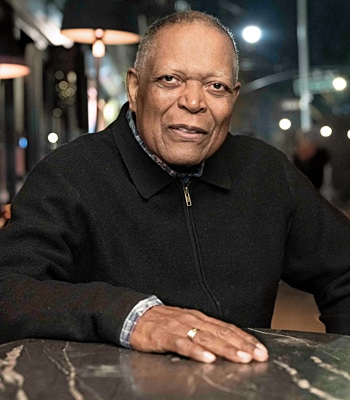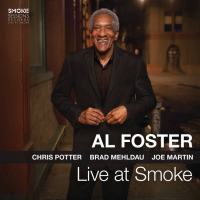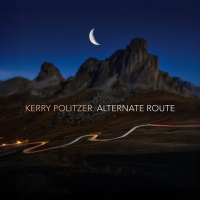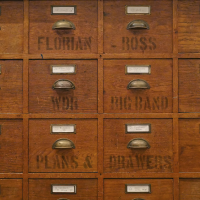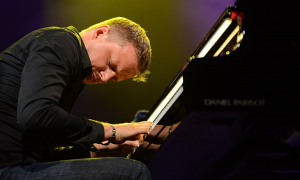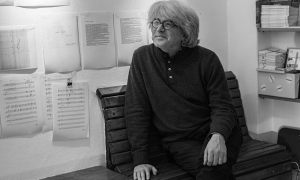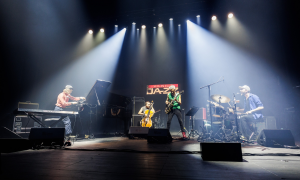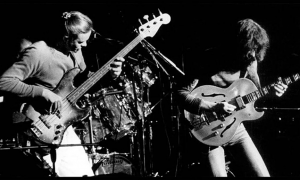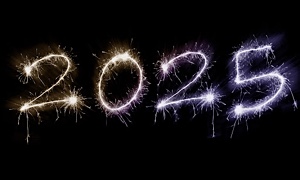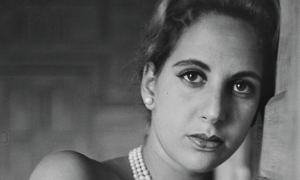Home » Jazz Articles » Interview » Meet Guitarist Adam Levy
Meet Guitarist Adam Levy
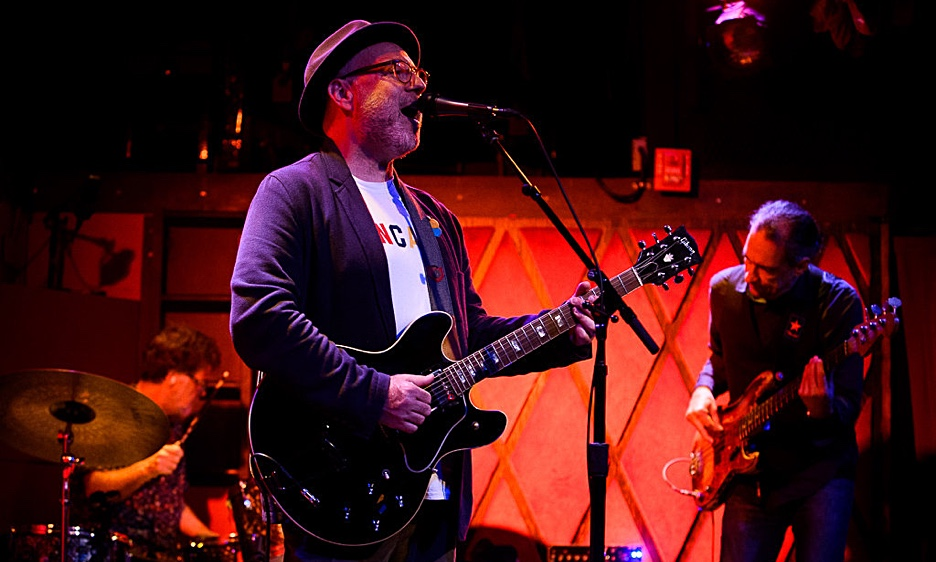
I loved him [Larry Carlton] as a kid, hearing him on the Crusaders records and on Steely Dan stuff. Everybody busts me for the Frisell influence—which I can't deny—but I hope there's more to my playing than just being a Frisell stylist.
Even if you have listened to jazz for a while, you might not have heard of Adam Levy, but you likely will, either through his higher profile efforts, including work with Tracy Chapman, Joey Baron, Sexmob, John Zorn, and now the latest Blue Note sensation, singer/pianist Norah Jones. Though Bill Frisell, Brian Blade and Kenny Wollesen, along with Levy, joined the Dallas native on her first major release, Levy is doing the tours, adding to her evocative voice and lyrics with a bluesy and decidedly minimalist, textural style.
Just back from a European tour with Jones' group to promote her Blue Note release, Come Away With Me and currently making the rounds of the late-night network shows (Conan, Late, Late Show, etc.) and SXSW showcases, the future seems to hold a lot of promise for this group. Levy has a lot to say both about this point in his career, creativity, recording his latest CD, and music in general.
All About Jazz: After listening to Buttermilk Channel (Lost Wax Music, 2001), I had to say that besides the obvious Frisell influence, I swear I heard Larry Carlton, too. It's a great record, too. Real bluesy, Hammond-trio stuff, but in a modern way.
Adam Levy: Glad you picked up on the Carlton thing. I loved him as a kid, hearing him on the Crusaders records and on Steely Dan stuff. Everybody busts me for the Frisell influence—which I can't deny—but I hope there's more to my playing than just being a Frisell stylist. If you hear me on Joey's disc and/or the Dunn record, you'll find some other things in my playing, I'm sure. Sometimes I think of Buttermilk Channel as my "homage record," with nods to Frisell, Scofield, Strayhorn, and Carla Bley. Having made that type of artistic statement, I'm looking forward to defining my own concept more and more clearly with each future effort. Whatever, it's all good.
AAJ: Yeah, I can hear the influences...making records is a real personal journey of self-discovery. Lost Wax, your publishing company, is an intriguing name...how'd it come about?
AL: The short answer is that the name came to me in a dream—really. About 10 years ago, while living in San Francisco, I was heading my first jazz group as a composer/leader. I wanted to name it something more interesting than the Adam Levy Quartet, and wracked my brain for weeks, trying to find a name. One early morn, my eyes popped open suddenly, and I exclaimed to my girlfriend, "I've got it! Lost Wax Process!" She approved, and we went back to sleep. The band only lasted a couple of years, but I've retained the name Lost Wax Music for my record label and for publishing.
AAJ: Sounds like intuition was at work.
AL: I do think there's something about the ancient art of lost-wax casting that is similar to the musical process, in the way that a composition is the "cast" or "mold" into which you can pour improvisation, but I never took the metaphor too literally.
AAJ: That's interesting. I like the metaphors that, like the wax process, are a process to develop our sounds and styles over time; that it can't necessarily be done quickly, and that we have to burn away what we are to become what we are yet to be. It's a process. Are you involved in arts other than music?
AL: No, I'm not involved in any arts other than music (unless you count "bullshit artist").
AAJ: (laughs). Buttermilk Channel's another curious name. Any reference to amp and guitar tones?
AL: Yes—and no. I'm like names that are somehow evocative but not limiting in their interpretation. Buttermilk Channel is the name of a body of water between Red Hook (a Brooklyn, New York neighborhood) and Governor's Island. I don't even think they call the channel Buttermilk Channel anymore—this is from ages ago, when Walt Whitman lived in Brooklyn. Around the time I was writing music for the album that became Buttermilk Channel, I had just moved to Red Hook. In trying to get to know my neighborhood, I found some old nautical maps online. As soon as I saw the name, I knew it would be the title of my album. It represents something specific, but most people don't know the history of New York waterways, so they come up with all sorts of wild ideas for the title's meaning. It gets people's imaginations going, and I like that.
AAJ: For sure. I tend to do the same thing (multiple entendre for song/album titles). Sounds like all the stories people came up with for "Rikki Don't Lose that Number" were all wrong. What's interesting is that once you use a term, name, or reference in a new way, it retains that new association for others, sometimes even getting used as a new phrase. What are your current gear preferences?
AL: Guitars: 1972 Fender Telecaster, 1979 Gibson ES-335, 1964 Martin 0-18, 1964 Gibson LG-0.
Amps: 1968 Fender Princeton Reverb for live shows, 1964 Fender Princeton (without reverb) for recording.
Effects: MXR Distortion+ (distortion/overdrive pedal), Danelectro Tuna Melt (tremolo pedal). I only use the Tuna Melt when touring, in case the "rental amp du jour" doesn't have a good built-in tremolo; my Princeton amps have nice tremolo.
Picks: Fender heavy-gauge picks.
Slide: Dunlop model 222 brass slide.
Strings: D'Addario XL115 strings (.011-.049) for electric, Martin Marquis 80/20 Bronze light-gauge (.012-.052) for acoustic.
AAJ: I'm sure you hear this a lot, but you've got a bit of a Frisell sound/approach and that clean channel, blues thing happening.
AL: I first saw Bill Frisell in Santa Monica in 1989, when a friend called one night and asked if I wanted to go see Frisell with him that night. This was about an hour before the show, so I think this guy's girlfriend must've canceled on him or something. Anyway, I was totally blown away by Bill Frisell and by his band—Joey Baron, Kermit Driscoll, Hank Roberts.
Having been born in 1966, I had no real chance of seeing Jimi Hendrix play, but when I saw Bill, I thought that the experience was the equivalent of seeing Hendrix and the Band of Gypsys, in the sense of how totally revolutionary it was. His approach was so different from anything I had ever heard. My main jazz guys at that point were probably Joe Pass, Larry Carlton, and John Scofield.
I loved—and still love—his ethereal legato phrasing, his use of open strings ringing against fretted notes, his unique wiggle-the-guitar-neck vibrato, and other unorthodox techniques—not to mention his ingenious note choices.
AAJ: Right. I remember the first time I heard Bill. It was in Cambridge, Massachusetts, at Johnathan Swift's, and he was with Eberhard Weber's group. What really struck me was how un-guitaristically he approached the instrument... it was much more textural with the volume pedal, bent neck, whammy bar, delays, etc. He didn't try to blow in a chops sense but added so much dimension with just those voicings and the right held note at the right time. Almost transcends the horn-like quality guitarists often go for. A very original voice.
AL: Also, he has usually emphasized guitar timbres that are more clean and spacious, which I've always been partial to. A few years before I heard Bill, I had a copy of Brian Eno's Apollo, with Daniel Lanois on guitar. Lanois' tones chime and echo beautifully on that record, and I listened to Apollo hundreds of times, mesmerized by the beauty of it. Frisell melded those shimmering tones with the harmonically adventurous compositions I was digging elsewhere—from Scofield, Stern, and early Carlton—so I was hooked.
AAJ: Yeah. Amen to the invention of the digital delay and analog chorus. Seems like a lot of guitarists were all searching for a more ethereal, evocative, tonal presence ... more like vocals or horns...and we've ended up with some great but very different proponents: Metheny, Stern, Frisell, Sco, Carlton, Holdsworth, etc. Larry Goldings and Wolleson are great support. What made you choose them for this, and can you discuss the making of that CD?
AL: I first met Kenny Wollesen when I moved from Los Angeles to San Francisco in 1989. By the time I made Buttermilk, he and I had been playing together for more than a decade, and had both been in New York for a few years already. He was the obvious choice for my album, because I knew how subtle he can be. In many ways, I'd say he approaches the drum set more like a percussionist than a drummer.
I wanted to make a mellow organ-trio record, which is a pretty novel idea. Before recording Buttermilk Channel, I had been listening obsessively to Jimmy Smith's Standards (Blue Note Records, 1998), which is all ballads, and that was a big inspiration for me. Donald Bailey played drums on that album, and Donald is one of Kenny's favorite players, so it all added up.
I had known Larry for a few years before we recorded Buttermilk Channel, but we had seldom played together. We'd hang out and go hear music together in New York, but rarely gigged. Still, I was very familiar with his playing, on Scofield's Hand Jive (Blue Note, 1994) and on Larry's own CDs. I was particularly knocked out by a piano-trio record he made with Paul Motian and Larry Grenadier called Awareness (Warner Bros., 1997). Wow! Along with that Jimmy Smith CD, Awareness was inspiring to me when I was first formulating my ideas for my own album. Another CD worth mentioning here is Wayne Horvitz's American Bandstand (Songlines, 2000). What American Bandstand and Awareness have in common is an introspective mood, subtle interplay—as opposed to just solo, solo, solo—and wondrous compositions. That was the target I was aiming for, with a little more emphasis on the blues feeling that I heard on the Jimmy Smith disc. By the way, Kenny Burrell is the guitarist on Standards, and it's my favorite recording he has ever done.
One downside to working with super-talented players like Kenny Wollesen and Larry Goldings is that they tend to be in high demand, so it was nearly impossible to find a day that they were both in town and available to record. Once I did nail down a date, everything really had to happen on that date. We couldn't come back the next day to fix things because Larry was leaving to go on the road with Michael Brecker, and Kenny was busy, too. It'd be another three months before we could get together again. No problem, I figured—we could nail the music in one day. But at around 5:30 in the afternoon, after four or five hours of recording, the engineer noticed that there was a technical problem that spoiled all of the music we had recorded so far. We already had good takes of everything, or so we thought, but now we'd have to start over from scratch and record the whole album in the remaining hours of the night with much of our energies already spent. Yikes! I figured my record was ruined. But the three of us went out to dinner, shared a bottle of wine, came back to the studio, and knocked out the whole record in a few hours—with just one or two takes of each song. That's the upside to working with great players. They don't lose their cool easily, and they can play their best under almost any circumstance.
AAJ: Man, that's tense. It's a drag to have a glitch wipe work so that it can't be used. Hope they comped you there. It's good that you were able to make the best of it and make it happen anyway. What about the Killer Joey disc and gigs with Joey Baron?
AL: I played with Joey's band for a while, around 1999. Steve Cardenas was the other guitarist, and Tony Scherr played bass. Playing with another guitarist—especially Steve, who I've known since 1990—made me get very clear about my own musical identity. Because after Steve would play a kick-ass solo, I'd have to follow him with my solo and play something fresh. Since he and I have a lot of the same influences, and were both playing the same kind of guitars (Gibson ES-335s) at the time, we both had to deal with identity issues. "Who am I?" "What do I sound like?" It was a pretty heavy growth period for me.
Joey is one of the greatest drummers alive, and he's also an inspiring band leader. He thinks about all of the aspects of group interplay and improvisation, and talks about it with the players. He has a very clear idea of what he wants, while still giving the players lots of room to do their thing. As a sideman, I appreciate his clarity and direction. When a leader has good ideas and can communicate them clearly, I actually feel freer, because I don't have to spend time and energy worrying about whether or not I'm playing the right stuff. Once Joey spelled out the things he wanted to hear from us—musically and sound-wise—we could focus on making good music together.
I started playing a different guitar because of my experience in Killer Joey. After we had played a few gigs, Joey asked me and Steve if we could find a way to sound less alike. For a gig or two, my Gibson was stuck in the repair shop, so I borrowed a Telecaster for a rehearsal with Killer Joey. Right away, it was clear that the band sounded more like what Joey had in mind. I stuck with it, and now I play a Tele more often than not. I've had a few of them. The main one I use is a 1972 Telecaster. Still, I've had my Gibson ES-335 since my bar mitzvah in 1979, so that guitar will always feel like home to me.
AAJ: Some of your higher profile gigs include Tracy Chapman, Zorn, Baron, Sex Mob, and now Norah Jones. Can you talk a bit about how each came about for you and how they differ?
AL: The Tracy Chapman connection came about when I was recommended for the gig by a friend. I auditioned, never dreaming I'd get the gig. But I did. I played with her for a year, 1994-5, and am featured on her New Beginning (Elektra Records, 19955) album.
I've only played with Zorn once or twice—on his improv nights at a club called Tonic, in New York City. I met him just by being on the scene in New York. In many ways, NYC is a small town, so you get to know the people in your scene pretty quickly. Zorn's improv nights are interesting. He calls several people to show up for the gig, with no advance planning. Then the players sit at the side of the stage while a duo or trio plays an improvised piece. When the mini-group onstage finishes, two or three other people follow immediately. The pairings keep mixing and changing, so everybody gets to play with everyone else in some combination. It's really fun and challenging. You never know who you'll be playing with, or where the music will go.
I met Sex Mob the same way as I met Zorn—just being on the scene. For a while in 1997, Sex Mob had a steady gig at the Knitting Factory. I was hanging out there a lot, and Steven Bernstein, the band's leader/trumpeter, knew of me through mutual friends. He asked me to sit in one week, and the music felt good. He kept inviting me back, and when they made their first CD, Din Of Inequity (Knitting Factory Works, 1998), he invited me to play on a few songs. I think that was the first recording I did in New York.
I met Norah three years ago in a bar in New York City, when she first came to New York from Dallas, Texas. We had some friends in common, we had musical interests in common, and we clicked together nicely. We've been playing together ever since—except for a year from summer 2000 to summer '01, when I was living in San Francisco.
AAJ: I saw the Late Late Show appearance with Norah. She sounds really great, really different.
AL: Norah's music is from a classic mold—with elements of jazz, folk, blues, and country—but the way she blends it all is totally original. It can sound familiar and new at the same time. She's a really gifted pianist and singer, and people tend to go crazy about her when they hear and see her. In just a few short years, she went from singing in New York nightclubs to a major deal with Blue Note Records, and now we're touring and doing television shows, and there has been lots of magazine coverage. Things are really blowing up quickly for her. Before making her own album, you might have heard her on Charlie Hunter's recent Songs From The Analog Playground (Blue Note, 2001).
AAJ: Frisell's on her new record with you, Brian Blade, and Wolleson. Were you all in the studio together, or was it different sessions?
AL: Different sessions for me and Frisell, I'm sorry to say. Brian Blade and I played together on "Nightingale" and maybe one or two others. He's amazing! I had never played with him before. Kenny and weren't together for these sessions. For most of my time in the studio with Norah Jones, the musicians present were Norah, me, Jesse Harris (acoustic guitar), Lee Alexander (bass), and Dan Rieser (drums). Guests while I was there included Sam Yahel (Hammond organ), Jenny Scheinman(violin), and Rob Burger (pump organ).
AAJ: What's your approach to writing?
AL: Usually, I sit down with my guitar, my metronome, and my little $39 Radio Shack cassette recorder. I'll set a tempo on the metronome and improvise in time, recording the whole session on a 60-minute tape. Usually within the first half-hour or so, I'm onto the seed of something, and by the time the tape runs out, I've got a song done—or nearly done. This is not the most scientific way to compose, I know, but it's tried and true for me.
AAJ: What's your background... education... who did you study with?
AL: In my teenage years, I studied guitar privately with Ted Greene, the Los Angeles jazz-guitar guru, and with Jimmy Wyble, an underrated player who worked with Red Norvo and with Bob Wills & His Texas Playboys. Their teaching styles are so different, as are their playing styles. Jimmy had me working on very specific exercises for my right and left hands, and these weren't just mechanical workouts—he paired rich musical contents with the knuckle-twisting fingerboard gymnastics. He also stretched my ears with his chromatic counterpoint etudes. Ted, on the other hand, mainly had me work with his solo-guitar arrangements of jazz standards, and also talked a lot about using blues phrasing within jazz improvisation. I remember one lesson with Ted where all we did was listen to Billy Butler's solo from Bill Doggett's recording of "Honky Tonk" over and over, and then talked about the structure and phrasing of it. What a lesson!
I also went to the Dick Grove School of Music in Los Angeles. I went through their guitar program and their composing/arranging program—both of which were one-year long and were excellent. The school has since gone out of business, unfortunately.
AAJ: Who are your main Influences?
AL: On the jazz side, my teachers, Jimmy Wyble and Ted Greene, were hugely influential, because these guys were the first great guitar players I ever had the opportunity to see and hear up close. My sense of what jazz guitar sounds like comes largely from my early experiences with them. I was also into Joe Pass' solo recordings back then, and Larry Carlton's first couple of records. Later, I went through phases when I was nuts about John Scofield, then Bill Frisell, then Jim Hall.
On the blues side of what I do, B.B. King is probably the strongest influence. If you listen to my solo on Tracy Chapman's "Give Me One Reason," you can hear lots of B.B. I also love Albert King, though I don't think I sound much like him. Also, I really dig Steve Cropper's work with Booker T. & the MGs. He wrote the book on Memphis soul guitar. Also great in that bag is Teenie Hodges, who played on all the classic Al Green records.
AAJ: Cool. What are you listening to these days?
AL: A lot of older stuff— Big Bill Broonzy Sings Folk Songs (Smithsonian Folkways Recordings, 1992), Etta James: At Last (Argo Records, 1960), George Harrison: All Things Must Pass (Apple Records, 1970)), The Best of Doc Watson: 1964—1968 (Vanguard Records, 1998), and a Tom Waits live bootleg from 1974. I also just picked up the new John Abercrombie)— Cat 'N' Mouse (ECM Records, 2002)—with Joey Baron and Mark Feldman on it. I can't wait to check it out.
AAJ: Yeah, ECM sent it to me last month, it's really interesting. What are your current and upcoming projects...anything you'd like to talk about?
AL: I'm pretty busy touring with Norah Jones. Her record seems to be taking off, and I enjoy working with her, so I'm blocking out most of this year to tour with her. She's such an inspiring singer and pianist, and she's got lots of great material.
I recently played on violinist Jenny Scheinman's next record, which will be coming out soon on John Zorn's Tzadik label. The band includes Kenny Wollesen on drums, Trevor Dunn on bass for half of the album and Greg Cohen on bass for the rest, and Russ Johnson on trumpet. I heard the rough mixes, and it sounds great. Jenny's an interesting composer, and I think I got to play some things on her record that are unusual for me.
I'm planning my next record, which I'll record later this year. I can't say much about it, because I've only got a few songs written. But I do have a concept in mind, with Memphis soul music being the backbone of the sound for the album. I may even record it down there.
I've been playing some concerts in tandem with other guitarists—Leni Stern, Will Bernard, and Jim Campilongo. On these shows, each of us does our own segments, and then we mix it up a little together. I'm playing my "Segments" solo, on acoustic guitar. Scary! If these concerts go well, I may make a solo-acoustic recording sometime soon.
AAJ: Very nice. Leni's great. Looking forward to the new releases.
AL: Good luck with your recording.
AAJ: Thanks, and all the best to you, too, Adam.
Tags
Interview
Adam Levy
Mike Brannon
Joey Baron
Sex Mob
john zorn
Norah Jones
Bill Frisell
Brian Blade
Dallas
Larry Carlton
steely dan
Kermit Driscoll
Hank Roberts
Joe Pass
Eberhard Weber
Jimmy Smith
Donald Bailey
Paul Motian
Larry Grenadier
Wayne Horvitz
Kenny Burrell
Larry Goldings
Steve Cardenas
Tony Scherr
Steven Bernstein
Charlie Hunter
Lee Alexander
Sam Yahel
Jenny Scheinman
Rob Burger
Bill Doggett
Trevor Dunn
Russ Johnson
Leni Stern
Will Bernard
Jim Campilongo
Jimi Hendrix
Kenny Wollesen
PREVIOUS / NEXT
Adam Levy Concerts
Support All About Jazz
 All About Jazz has been a pillar of jazz since 1995, championing it as an art form and, more importantly, supporting the musicians who make it. Our enduring commitment has made "AAJ" one of the most culturally important websites of its kind, read by hundreds of thousands of fans, musicians and industry figures every month.
All About Jazz has been a pillar of jazz since 1995, championing it as an art form and, more importantly, supporting the musicians who make it. Our enduring commitment has made "AAJ" one of the most culturally important websites of its kind, read by hundreds of thousands of fans, musicians and industry figures every month.


